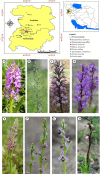Exploring genetic variations in threatened medicinal orchids using start codon targeted (SCoT) polymorphism and marker-association with seed morphometric traits
- PMID: 33967461
- PMCID: PMC8055808
- DOI: 10.1007/s12298-021-00978-4
Exploring genetic variations in threatened medicinal orchids using start codon targeted (SCoT) polymorphism and marker-association with seed morphometric traits
Abstract
We aimed to study the genetic diversity and population structure of eight Iranian terrestrial orchid species, including Anacamptis coriophora (L.) R. M. Bateman, Pridgeon and M. W. Chase, Dactylorhiza umbrosa (Kar. & Kir.) Nevski, Himantoglossum affine (Boiss.) Schltr., Orchis collina Banks and Solander, Orchis mascula (L.) L., Orchis simia Lam., Ophrys schulzei Bornm. and Fleischm., and Ophrys straussii H. Fleischm. and Bornm. using start target codon markers (SCoT) and finding markers associated with seed morphometric traits. A total of 254 reproducible SCoT fragments were generated, of which 248 fragments were polymorphic (average polymorphism of 96.18%). The SCoT markers showed a narrow range of polymorphism information content (PIC) varied from 0.397 for S9 primer to 0.499 for S11 and S20 primers. Based on the population analysis results, the Orchis simia accessions collected from Paveh region (Os.P) represented the lowest observed number of alleles (Na) (1.13) and effective number of alleles (Ne) (1.09). At the same time, the highest Na (1.29) and Ne (1.18) values were obtained in O. schulzei collected from Javanrood (Oyst.JA). Shannon's information index (I) was ranged from 0.03 for D. umbrosa accessions collected from Marivan (Du.M population) to 0.263 for Ha.Ja population (H. affine accessions collected from Javanrood). The UPGMA dendrogram obtained with the Jaccard similarity coefficient (r = 0.97295) divided 97 studied terrestrial orchid accessions into eight groups mainly based on species type and geographical origin. Based on the Bayesian statistical index, the highest probability of the data was achieved when accessions were divided into eight groups (K = 8). Multiple association analysis (MRA) revealed significant associations between some of SCoT bands with seed morphometric traits. Our findings can be useful for germplasm characterization, conservation, and improvement of Iranian terrestrial orchid species.
Supplementary information: The online version contains supplementary material available at 10.1007/s12298-021-00978-4.
Keywords: Conservation; Iranian orchids; Population structure; RET species; SCoT.
© Prof. H.S. Srivastava Foundation for Science and Society 2021.
Conflict of interest statement
Conflict of interestThe authors declare that they have no confict of interest.
Figures





Similar articles
-
Molecular characterization of endangered Iranian terrestrial orchids using ISSR markers and association with floral and tuber-related phenotypic traits.Physiol Mol Biol Plants. 2021 Jan;27(1):53-68. doi: 10.1007/s12298-020-00920-0. Epub 2021 Jan 16. Physiol Mol Biol Plants. 2021. PMID: 33627962 Free PMC article.
-
Assessment of genetic diversity in Vigna unguiculata L. (Walp) accessions using inter-simple sequence repeat (ISSR) and start codon targeted (SCoT) polymorphic markers.BMC Genet. 2017 Nov 17;18(1):98. doi: 10.1186/s12863-017-0567-6. BMC Genet. 2017. PMID: 29149837 Free PMC article.
-
Genetic diversity and structure of Capsicum annuum as revealed by start codon targeted and directed amplified minisatellite DNA markers.Hereditas. 2019 Oct 16;156:32. doi: 10.1186/s41065-019-0108-6. eCollection 2019. Hereditas. 2019. PMID: 31641342 Free PMC article.
-
Deciphering the level of genetic diversity in some aegilops species using CAAT box-derived polymorphism (CBDP) and start codon target polymorphism (SCoT) markers.Mol Biol Rep. 2023 Jul;50(7):5791-5806. doi: 10.1007/s11033-023-08488-0. Epub 2023 May 23. Mol Biol Rep. 2023. PMID: 37219668
-
Start codon targeted (SCoT) polymorphism marker in plant genome analysis: current status and prospects.Planta. 2023 Jan 9;257(2):34. doi: 10.1007/s00425-023-04067-6. Planta. 2023. PMID: 36622439 Review.
Cited by
-
The impact of environmental and climatic variables on genetic diversity and plant functional traits of the endangered tuberous orchid (Orchis mascula L.).Sci Rep. 2022 Nov 17;12(1):19765. doi: 10.1038/s41598-022-19864-4. Sci Rep. 2022. PMID: 36396718 Free PMC article.
-
Cis-element amplified polymorphism (CEAP), a novel promoter- and gene-targeted molecular marker of plants.Physiol Mol Biol Plants. 2022 Jul;28(7):1407-1419. doi: 10.1007/s12298-022-01212-5. Epub 2022 Aug 2. Physiol Mol Biol Plants. 2022. PMID: 36051234 Free PMC article.
-
Molecular phylogeny of plant pathogenic fungi based on start codon targeted (SCoT) polymorphism.Mol Biol Rep. 2023 Oct;50(10):8271-8279. doi: 10.1007/s11033-023-08735-4. Epub 2023 Aug 14. Mol Biol Rep. 2023. PMID: 37578578
-
Genetic marker: a genome mapping tool to decode genetic diversity of livestock animals.Front Genet. 2024 Oct 17;15:1463474. doi: 10.3389/fgene.2024.1463474. eCollection 2024. Front Genet. 2024. PMID: 39483851 Free PMC article. Review.
References
-
- Akçin TA, Ozdener Y, Akçin A. Taxonomic value of seed characters in orchids from Turkey. Belg J Bot. 2009;142(2):124–139.
-
- Aybeke M. Pollen and seed morphology of some Ophrys L. (Orchidaceae) taxa. J Plant Biol. 2007;50(4):387–395. doi: 10.1007/bf03030673. - DOI
-
- Azizi A, Wagner C, Honermeier B, Friedt W. Intraspecific diversity and relationship between subspecies of Origanum vulgare revealed by comparative AFLP and SAMPL marker analysis. Plant Syst Evol. 2009;281(1–4):151–160. doi: 10.1007/s00606-009-0197-1. - DOI
-
- Barthlott W, Große-Veldmann B, Korotkova N. Orchid seed diversity: a scanning electron microscopy survey. Englera. 2014;32:1–245.
LinkOut - more resources
Full Text Sources
Other Literature Sources
